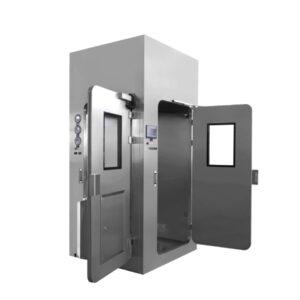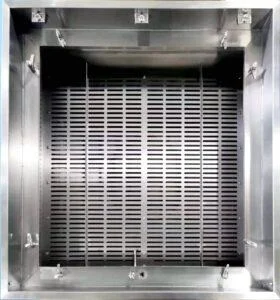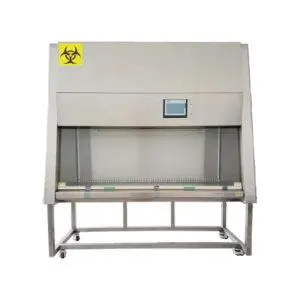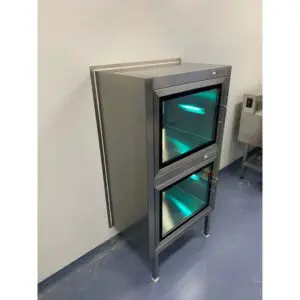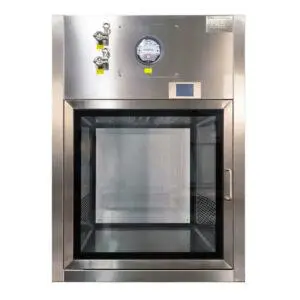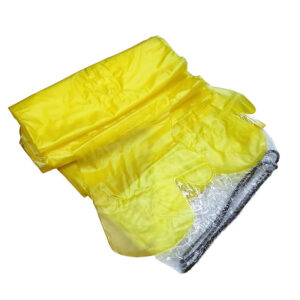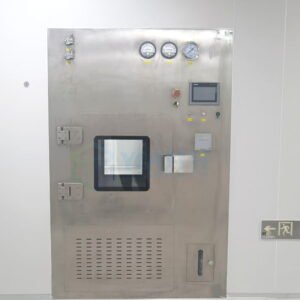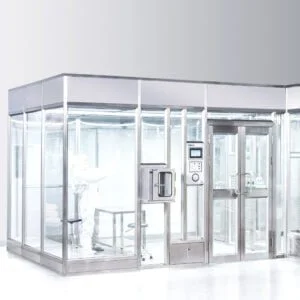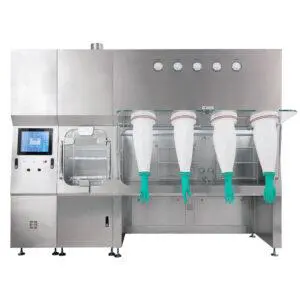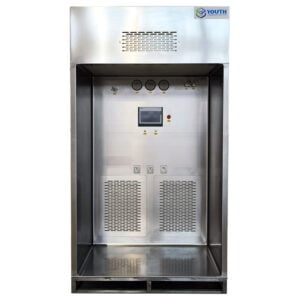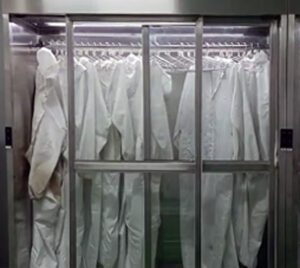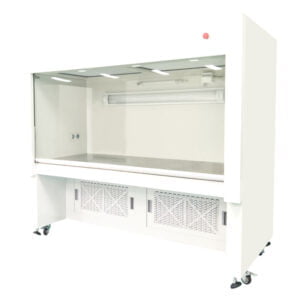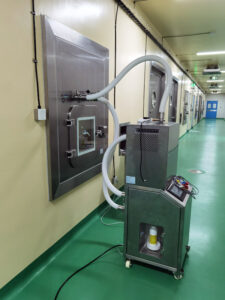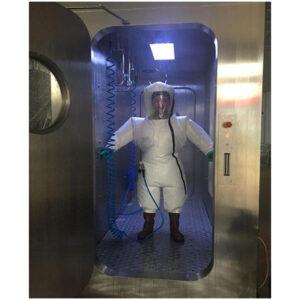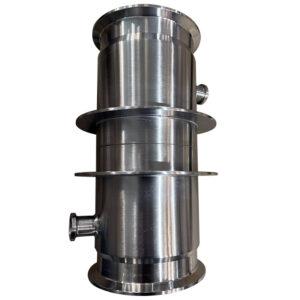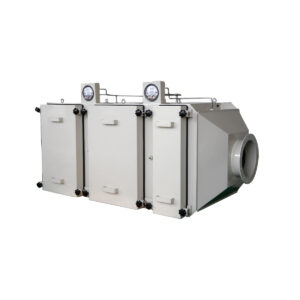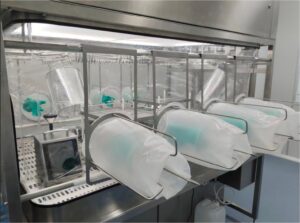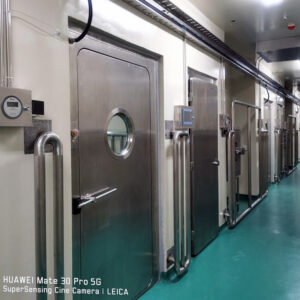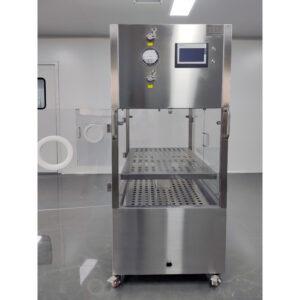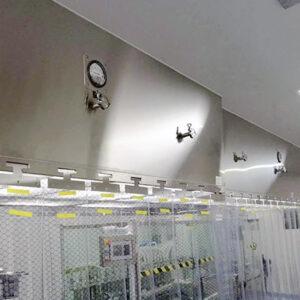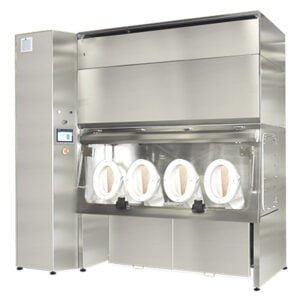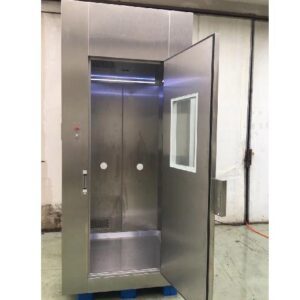Understanding Cleanroom Gloves Dispensers
In controlled environments where contamination can compromise product integrity or research outcomes, the humble gloves dispenser serves as a critical first line of defense. Stainless steel gloves dispensers aren’t merely storage units—they’re engineered contamination control tools that maintain the sterility and accessibility of protective hand coverings in cleanroom environments.
The fundamental purpose of these dispensers extends beyond simple organization. They prevent direct handling of multiple gloves (which would transfer contaminants), maintain order in critical spaces, and ensure proper protocol is followed during gloving procedures. Unlike consumer-grade alternatives, cleanroom-specific dispensers must meet exacting standards for material composition, finish quality, and design features that minimize particle generation.
Stainless steel—typically medical-grade 304 or 316—has become the gold standard material for these applications due to its non-shedding properties, chemical resistance, and compatibility with rigorous cleaning protocols. The YOUTH Tech dispensers utilize 304 stainless steel with a brushed finish specifically designed to prevent particle harboring while withstanding harsh disinfectants.
These dispensers generally fall into several categories based on mounting and capacity requirements:
- Wall-mounted units that conserve valuable floor space while providing easy access
- Free-standing dispensers for flexible deployment in changing cleanroom layouts
- Multi-box configurations that accommodate various glove sizes or types in a single unit
- Pass-through designs integrated into wall systems for restocking without cleanroom entry
What makes these seemingly simple devices so critical is their position in the contamination control workflow. As the interface between the personal protection equipment and the human operator, they represent a potential transfer point for contaminants if not properly maintained. A technician accessing gloves from a contaminated dispenser effectively negates the protection those gloves would otherwise provide.
In ISO-classified cleanrooms ranging from ISO 3 to ISO 8, these dispensers must comply with specific materials requirements while maintaining validated cleanliness levels. The regulatory frameworks governing pharmaceutical manufacturing (GMP), semiconductor production, and medical device assembly all recognize proper glove dispensing as essential to contamination control strategies.
The design features of high-performance cleanroom gloves dispensers also reflect their specialized purpose, including:
- Rounded corners to eliminate particle-trapping edges
- Seamless construction where possible to reduce cleaning challenges
- Electropolished surfaces that resist microbial attachment
- Accessible mounting systems that allow cleaning behind the unit
- Secure but easy-access openings that protect contents while facilitating retrieval
Understanding these design elements provides the foundation for implementing effective maintenance protocols—the key to ensuring these devices fulfill their contamination control purpose throughout their operational lifespan.
The Science of Contamination in Gloves Dispensers
The stainless steel surface of a gloves dispenser might appear pristine to the naked eye, but at the microscopic level, a complex ecosystem of contaminants can develop over time. Understanding these contamination mechanisms is essential to developing appropriate cleaning frequencies and methods.
Cleanroom dispensers typically face three primary contamination categories: particulate, microbial, and chemical. Each presents unique challenges and requires specific mitigation strategies.
Particulate contamination occurs through normal airborne deposition, with particles ranging from sub-micron to visible dust. Though cleanrooms control ambient particle counts, zero particulate environments don’t exist in practical settings. Studies have shown that even in ISO 5 environments, stainless surfaces can accumulate 5-10 particles per square centimeter daily in the 0.5μm to 5μm range. These particles often concentrate around the dispenser opening where turbulent airflow patterns develop during glove retrieval.
Dr. Jennifer Ramirez, a cleanroom validation specialist I consulted with last year, explained: “The dispenser opening creates a microenvironment where air currents behave differently than in the general room. This vortex effect can actually concentrate particles precisely where you don’t want them—at the point where clean gloves are being accessed.”
Microbial contamination presents even greater concerns, particularly in pharmaceutical and medical device manufacturing. Viable organisms transferred from operator hands, clothing, or the surrounding environment can attach to dispenser surfaces and potentially form biofilms if cleaning is inadequate. Research published in the Journal of Contamination Control demonstrated that stainless steel surfaces can harbor viable microorganisms for 72-96 hours, even in low-humidity environments.
The contamination transfer mechanism typically follows predictable patterns:
- Operators touch the dispenser opening when retrieving gloves
- Microorganisms transfer from hands to the stainless surface
- Subsequent users contact these same areas
- Cross-contamination occurs between operators and ultimately to products
Chemical contamination, while less obvious, can be equally problematic. Residues from cleaning agents, process chemicals, or even hand sanitizers can accumulate on dispenser surfaces. These residues may transfer to gloves and ultimately to products or processes. This is particularly concerning in semiconductor manufacturing, where even trace chemical contaminants can compromise wafer production.
The physical design of many dispensers inadvertently creates contamination “hot spots”—areas where cleaning is difficult and contaminants accumulate. Common problem areas include:
- Box retention mechanisms with complex geometry
- Seams and joints where components meet
- Mounting hardware and associated recesses
- Dispenser openings with irregular shapes
- Label adhesive residue areas
What makes contamination control particularly challenging is that these dispensers exist at the intersection between the controlled cleanroom environment and human operators—the primary source of contamination in most cleanroom settings. Each time someone accesses gloves, they potentially deposit new contaminants on or around the dispenser.
This understanding of contamination mechanisms forms the scientific basis for determining appropriate cleaning frequencies. Rather than arbitrary schedules, effective maintenance protocols should address the specific contamination risks present in each unique cleanroom environment.
Establishing Optimal Cleaning Frequency for Gloves Dispenser Maintenance
Determining how often to clean stainless steel gloves dispensers requires balancing multiple variables rather than following a one-size-fits-all approach. While manufacturers sometimes provide general guidelines, the reality is that optimal frequency depends heavily on your specific operational environment and risk profile.
ISO classification provides a useful starting framework, as the cleanroom classification directly correlates with acceptable contamination levels. As a general guideline:
| ISO Class | Recommended Cleaning Frequency |
|---|---|
| ISO 3-4 | Daily to twice daily cleaning with weekly deep cleaning |
| ISO 5-6 | Daily cleaning with biweekly deep cleaning |
| ISO 7-8 | Every 2-3 days with monthly deep cleaning |
| ISO 9 | Weekly with monthly deep cleaning |
However, these frequencies should be adjusted based on several critical factors that can significantly affect contamination rates.
The traffic volume and handling frequency create perhaps the most significant variable. A dispenser accessed 50 times daily in a moderate-classification cleanroom may require more frequent cleaning than one accessed only occasionally in a more stringent environment. During a cleanroom optimization project I led at a medical device manufacturer, we discovered that dispenser contamination correlated more strongly with access frequency than with room classification.
Industry-specific considerations also play a major role in establishing appropriate cleaning schedules:
For pharmaceutical environments operating under GMP requirements, cleaning validation becomes a regulatory necessity. The cleaning frequency must be validated through direct testing to demonstrate consistent removal of viable contamination. Robert Chen, a GMP compliance consultant, notes that “pharmaceutical facilities should establish their cleaning frequencies based on recovery testing data rather than industry standards or manufacturer recommendations.”
Semiconductor facilities face different challenges, primarily related to ionic and molecular contamination. Their cleaning protocols typically emphasize removal of trace chemicals that could impact wafer production. Here, weekly cleaning with specialized non-ionic detergents followed by IPA rinses has become standard practice in many fabs.
Medical device manufacturing presents a middle ground, with both particulate and viable contamination concerns. The common approach involves daily surface cleaning with more thorough weekly sanitization.
Research facilities with varying protocols may need customized schedules based on the specific contaminants of concern in their work. A genomics lab, for instance, would prioritize preventing DNA cross-contamination, while a cell culture facility would focus on microbial control.
Beyond these industry-specific approaches, environmental factors significantly influence cleaning requirements. Consider:
- Higher room humidity (above 40%) accelerates microbial growth, necessitating more frequent cleaning
- Cleanrooms with positive pressure differentials may accumulate less contamination around doors
- Seasonal variations in external environments can affect contamination levels
- HVAC maintenance activities often introduce temporary contamination spikes
The most effective approach involves implementing a risk assessment methodology for gloves dispenser maintenance. This process:
- Identifies critical control points in your specific environment
- Establishes contamination limits for each surface type
- Implements monitoring to detect when cleaning is necessary
- Documents cleaning effectiveness through verification testing
During implementation, it’s wise to establish a more aggressive initial cleaning schedule, then adjust based on validation data. In a biologics manufacturing facility conversion I consulted on, we initially established daily cleaning, then extended to three-day intervals after demonstrating consistent sub-threshold contamination levels through ATP testing.
A crucial aspect often overlooked is the distinction between routine cleaning and periodic deep cleaning. Surface disinfection might occur daily, while more comprehensive disassembly and cleaning of mounting hardware might happen monthly. This tiered approach ensures resource efficiency while maintaining appropriate contamination control.
The bottom line? Your optimal cleaning frequency should be determined through a combination of industry standards, risk assessment, and—most importantly—validation data specific to your operational environment.
Comprehensive Cleaning Protocols for Stainless Steel Dispensers
Effective cleaning of stainless steel gloves dispensers requires more than simply wiping down surfaces. A properly documented and executed cleaning protocol ensures consistent results while protecting the dispenser’s integrity. The following methodology has proven effective across various cleanroom environments.
Before beginning, gather appropriate cleaning materials compatible with both your cleanroom classification and stainless steel surfaces:
- Low-linting cleanroom wipes (polyester-cellulose blend or 100% polyester)
- Primary cleaning agent (typically a non-ionic detergent or specialized cleanroom cleaner)
- Disinfection agent (isopropyl alcohol, hydrogen peroxide, or quaternary ammonium depending on requirements)
- Sterile water for rinsing if required by your protocol
- Appropriate PPE including clean gloves and garments
The basic cleaning sequence follows these steps:
Preparation: Remove empty glove boxes and clear the area around the dispenser. If wall-mounted, ensure access to all surfaces including behind and underneath the unit.
Initial inspection: Examine the dispenser for visible contamination, damage, or wear that might require special attention or repair.
Gross cleaning: Using a cleanroom-compatible detergent solution, remove visible contamination. Work from top to bottom and from cleaner to more contaminated areas.
Focus on critical areas: Pay special attention to:
- The dispenser opening where gloves are accessed
- Corners and joints where particles accumulate
- Mounting hardware and brackets
- Box retention mechanisms
- Any areas showing visible residue
Disinfection phase: Apply the appropriate disinfectant using fresh wipes. Ensure proper wet contact time according to the disinfectant manufacturer’s specifications.
Rinse if necessary: Some cleaning agents require a rinse step to prevent residue. Use clean wipes with sterile water if needed.
Final inspection: Visually inspect all surfaces under appropriate lighting.
Documentation: Record the cleaning in your maintenance log, noting any issues requiring follow-up.
When selecting cleaning agents, compatibility with 304/316 stainless steel is paramount. The following table outlines common cleanroom cleaning agents and their compatibility:
| Cleaning Agent | Compatibility with Stainless Steel | Effectiveness Against | Residue Concerns |
|---|---|---|---|
| 70% IPA | Excellent | Microbial contamination, light oils | Low residue, quick evaporation |
| Hydrogen Peroxide (3-6%) | Good | Broad spectrum microbial | May require rinsing |
| Quaternary Ammonium Compounds | Good | Bacteria and fungi | Can leave film requiring rinse |
| Sodium Hypochlorite (Bleach) | Poor – can pit stainless | Broad spectrum | High residue, requires thorough rinsing |
| Phenolic Compounds | Moderate | Bacteria, limited virucidal | May leave residue |
| Peracetic Acid | Moderate – can damage at high conc. | Broad spectrum, sporicidal | Requires thorough rinsing |
Material compatibility becomes especially important with repeated cleaning. Michael Sanchez, a stainless steel manufacturing specialist, cautions: “The biggest mistake I see in cleanrooms is using aggressive chlorinated cleaners on stainless steel. While 304 and 316 stainless are corrosion-resistant, repeated exposure to chlorides can eventually cause pitting and create contamination traps.”
For multi-part stainless steel cleanroom gloves dispensers, periodic disassembly and deeper cleaning may be necessary. This typically involves:
- Removing the dispenser from its mounted position
- Disassembling removable components according to manufacturer guidelines
- Cleaning individual components with attention to crevices and joining areas
- Thoroughly drying all components before reassembly
- Validating proper reassembly and function before returning to service
Validation of cleaning effectiveness represents the critical final step in any cleaning protocol. Several methods are commonly employed:
- Visual inspection under appropriate lighting
- ATP (Adenosine Triphosphate) testing for biological residue
- Swab sampling with microbial growth media
- Particle monitoring of surfaces with specialized instruments
- Residue testing for chemical cleaner residuals
Documentation requirements vary by industry but generally include:
- Date and time of cleaning
- Personnel performing the cleaning
- Cleaning agents used with lot numbers
- Verification method and results
- Any deviations from standard protocol
- Corrective actions if required
As Dr. Lisa Martin, a contamination control specialist, explained during a recent conference panel: “The cleaning protocol is only as good as your verification method. Without some form of objective testing, you’re simply assuming your cleaning is effective.”
By implementing a comprehensive, documented cleaning protocol, you ensure that your stainless steel gloves dispensers remain an effective part of your contamination control strategy rather than becoming a contamination vector.
Preventative Maintenance Beyond Cleaning
While regular cleaning addresses surface contamination, comprehensive gloves dispenser maintenance extends beyond sanitization alone. Preventative maintenance identifies and addresses potential issues before they impact dispenser functionality or contamination control effectiveness.
Regular inspection should include checking for:
- Surface damage including scratches that could harbor contaminants
- Corrosion, particularly at joints and mounting points
- Loose or damaged mounting hardware
- Deformation around the dispensing opening from frequent use
- Wear on box retention mechanisms
- Proper alignment and function of movable parts
These inspections often reveal early indicators of problems that, if addressed promptly, can extend dispenser lifespan significantly. I recently consulted with a biotech facility where dispensers were being replaced every 18 months due to corrosion issues. Upon investigation, we discovered that their cleaning protocol was allowing solution to pool at mounting points, causing premature deterioration. A simple protocol adjustment extended expected lifespan to over five years.
Preventative measures that complement regular cleaning include:
Surface protection – Application of appropriate protective treatments to vulnerable areas. Some facilities apply thin silicone-based protectants to high-touch areas, though these must be carefully selected for cleanroom compatibility.
Hardware maintenance – Periodic checking and tightening of mounting hardware prevents loosening vibration and ensures dispensers remain properly secured. Use appropriate thread-locking compounds compatible with cleanroom environments.
Gasket and seal inspection – Where applicable, examine seals and gaskets for deterioration. These components often degrade faster than stainless components and may require replacement.
Lubrication of moving components – Some dispenser designs incorporate sliding components that benefit from minimal application of cleanroom-compatible lubricants. Consult manufacturer specifications for guidelines.
Mounting system evaluation – Wall-mounted dispensers place stress on both the dispenser and the mounting surface. Periodic inspection of the wall area surrounding anchors is advisable.
Recognizing when maintenance is insufficient and replacement becomes necessary is also important. Key indicators include:
- Visible corrosion that cannot be removed through cleaning
- Structural deformation that affects functionality
- Surface damage that creates cleaning challenges
- Components that no longer maintain proper alignment
- Mounting points that show signs of metal fatigue
A simple cost-benefit analysis often helps facility managers determine the transition point from maintenance to replacement:
| Consideration | Maintenance Approach | Replacement Approach |
|---|---|---|
| Initial Cost | Lower short-term expense | Higher immediate investment |
| Staff Time | Regular time commitment | One-time installation with reduced maintenance |
| Contamination Risk | Potentially higher with aging equipment | Reduced with new equipment |
| Compliance Confidence | May diminish over time | High with new equipment |
| Appearance | Gradual degradation | Maintains professional environment |
| Total Cost of Ownership | Usually higher over extended periods | Often lower when factoring all costs |
When working with semiconductor manufacturers, I’ve observed the implementation of “preventative replacement” programs—scheduling dispenser replacement at regular intervals regardless of condition. While this approach increases equipment costs, it dramatically reduces the risk of contamination events that could compromise million-dollar production runs.
For facilities with numerous dispensers, creating a staggered replacement schedule helps distribute costs while ensuring the gradual introduction of improved designs and technologies. This approach allows for budgeting predictability while maintaining state-of-the-art equipment.
One often overlooked aspect of maintenance is the documentation system itself. Implementing electronic tracking of gloves dispenser maintenance activities enables trend analysis that can identify patterns of wear or contamination. These patterns frequently point to underlying environmental or procedural factors that, when addressed, can extend the service life of all cleanroom equipment.
By integrating preventative maintenance with cleaning protocols, facilities can optimize both the functional lifespan and contamination control effectiveness of their stainless steel gloves dispensers.
Case Studies: Real-World Maintenance Programs
The theoretical framework for dispenser maintenance provides guidance, but examining actual implementation across different industries offers valuable practical insights. The following case studies illustrate how various facilities have optimized their gloves dispenser maintenance programs to address their unique challenges.
Pharmaceutical Manufacturing: Balancing Compliance and Efficiency
A large-scale pharmaceutical manufacturer producing injectable medications operates multiple ISO 5 and ISO 7 cleanroom suites. Their initial approach followed conservative guidelines with daily cleaning of all dispensers regardless of location or usage.
After conducting a six-month validation study using ATP testing and microbial sampling, they implemented a risk-based approach that significantly reduced maintenance requirements without compromising cleanliness:
- High-traffic dispensers in ISO 5 areas: Maintained daily cleaning
- Low-traffic dispensers in ISO 5 areas: Reduced to three times weekly
- Dispensers in ISO 7 transition areas: Reduced to twice weekly
- Implemented monthly deep cleaning for all dispensers
The validation data showed no statistically significant difference in contamination levels between daily cleaning and the optimized schedule. This risk-based approach reduced cleaning labor by approximately 45% while maintaining full GMP compliance.
Their documentation system incorporates electronic records with barcode scanning, allowing for real-time verification that each dispenser is cleaned according to schedule. The system automatically flags missed cleanings and generates compliance reports for regulatory inspections.
Quality Assurance Director Maria Chen noted, “The data-driven approach gave us confidence to optimize our protocols while maintaining our compliance standards. The key was establishing appropriate alert and action limits for each location based on historical data.”
Semiconductor Manufacturing: Contamination Source Identification
A semiconductor fabrication facility producing 300mm wafers implemented a comprehensive approach to dispenser maintenance after discovering that particulate contamination on wafers correlated with glove handling.
Their innovative program included:
- Weekly comprehensive cleaning of all dispensers
- Daily spot-cleaning of dispenser openings and high-touch areas
- Particle testing of dispensers using surface particle counters
- Strategic placement of particle counters near glove dispensing stations
- Root cause analysis when particle excursions occurred
The facility identified several crucial factors affecting dispenser contamination:
- Airflow patterns around dispensers significantly impacted particle accumulation
- Box replacement activities generated more particles than daily use
- Vertical mounting created less contamination than horizontal orientations
They modified their dispenser configuration to optimize airflow patterns and implemented procedural controls around box replacement. These changes reduced particle counts by 67% at dispensing stations and contributed to a measurable improvement in wafer yields.
Medical Device Manufacturing: Multi-Site Standardization
A medical device company with eight manufacturing locations faced challenges maintaining consistent gloves dispenser maintenance across facilities. Each site had developed somewhat different protocols, making quality consistency difficult to verify.
They undertook a standardization initiative that included:
- Replacement of varied dispenser types with identical stainless steel models across all sites
- Development of a unified cleaning SOP with clear visual instructions
- Implementation of a centralized verification program with standardized testing methods
- Training program with competency verification for all cleanroom staff
The standardization effort revealed significant variability in cleaning effectiveness between sites despite similar documented procedures. The investigation identified differences in cleaning materials, technique, and verification methods as contributing factors.
After implementing standardized protocols and verification methods, cross-site contamination variability decreased by 78%. The company also documented a reduction in glove-related contamination events across all facilities.
Operations Director James Wilson explained: “What surprised us most was how much tribal knowledge existed at each site. The standardization process uncovered numerous undocumented ‘adjustments’ to the official procedures that had evolved over time.”
Biotech Research Facility: Integration with Environmental Monitoring
A genomics research facility with sensitive PCR operations took an integrated approach to dispenser maintenance, linking it directly to their environmental monitoring program.
Their system includes:
- Routine weekly cleaning of all dispensers
- Targeted cleaning based on environmental monitoring data
- Settled plate testing near critical dispensers
- Correlation analysis between dispenser cleaning and environmental counts
By analyzing the relationship between cleaning activities and environmental monitoring results, they identified optimal cleaning timing that maximized cleanliness during critical operations while minimizing disruption during research procedures.
The key insight from these case studies is that effective maintenance programs are rarely static. They evolve through continuous improvement processes based on monitoring data, operational observations, and changing facility requirements. The most successful programs integrate dispenser maintenance into broader contamination control strategies rather than treating it as an isolated activity.
Future Trends in Dispenser Technology and Maintenance
The cleanroom equipment industry continues to evolve, with several emerging technologies and approaches poised to transform how we maintain and utilize gloves dispensers. Understanding these trends helps contamination control professionals prepare for future capabilities and challenges.
Smart Dispensers with Monitoring Capabilities
The integration of IoT (Internet of Things) technology into cleanroom equipment is creating opportunities for real-time monitoring of dispenser conditions. Prototype systems currently in development incorporate:
- Embedded sensors that detect handling frequency and patterns
- Surface particulate monitors that trigger cleaning notifications
- Usage tracking to optimize glove inventory and replacement timing
- Contamination detection using fluorescence or spectroscopy
- Integration with building management systems
These technologies enable predictive maintenance approaches where cleaning occurs based on actual contamination levels rather than arbitrary schedules. Early adopters report significant efficiency improvements while maintaining or improving cleanliness levels.
Dr. Richard Zhang, cleanroom technology researcher, explains: “The next generation of dispensers won’t just passively hold gloves—they’ll actively participate in contamination control by monitoring their own condition and alerting staff when intervention is needed.”
Self-Cleaning and Antimicrobial Technologies
Material science advances are creating surfaces with inherent antimicrobial properties or self-cleaning capabilities:
- Copper-infused stainless steel alloys that provide continuous antimicrobial action
- Photocatalytic coatings that break down organic contaminants under cleanroom lighting
- Hydrophobic nano-coatings that resist bacterial attachment and biofilm formation
- Electrostatic systems that actively repel particles
While these technologies won’t eliminate the need for manual cleaning, they may extend intervals between cleanings and provide additional contamination protection. The incorporation of antimicrobial materials shows particular promise for dispensers located in biosafety environments where microbial control is paramount.
Sustainable Cleaning Approaches
Environmental considerations are driving development of more sustainable cleaning methodologies:
- Engineered water systems that clean effectively without chemical agents
- Concentrated cleaning products that reduce packaging and shipping impacts
- Reusable or biodegradable cleaning materials that decrease waste
- Energy-efficient sanitization technologies like targeted UV systems
These approaches not only reduce environmental impact but often provide economic benefits through reduced chemical usage and waste disposal costs. A pharmaceutical manufacturer I worked with recently implemented an electrolyzed water cleaning system for their cleanroom gloves dispensers and reported a 30% reduction in cleaning costs alongside improved staff satisfaction.
Integration with Cleanroom Monitoring Systems
The trend toward comprehensive cleanroom monitoring creates opportunities for integrating dispenser maintenance with broader contamination control systems:
- Centralized scheduling systems that coordinate cleaning with production activities
- Automated documentation that reduces compliance burden
- Data analytics that correlate dispenser condition with environmental monitoring results
- Risk-based approaches that adjust procedures based on real-time operations
This integration enables more sophisticated contamination control strategies where resources are allocated based on actual risk rather than standardized schedules. The resulting efficiency improvements can be substantial—one medical device manufacturer reported reducing cleaning labor by 40% while improving contamination control metrics after implementing an integrated monitoring approach.
Advanced Material Design
Dispenser design itself continues to evolve with emphasis on:
- Reduction or elimination of horizontal surfaces that collect particles
- Seamless construction that minimizes cleaning challenges
- Modular components that facilitate deep cleaning
- Materials engineered specifically for cleanroom compatibility
These design improvements address many of the maintenance challenges associated with current dispenser models, potentially allowing less frequent but more effective cleaning interventions.
The future maintenance landscape will likely feature a hybrid approach combining scheduled maintenance with condition-based interventions triggered by monitoring systems. This evolution parallels developments in other industries where predictive maintenance has revolutionized equipment management.
For cleanroom managers planning equipment upgrades, considering these emerging technologies during procurement may yield significant long-term advantages in both contamination control effectiveness and operational efficiency.
Balancing Factors: A Practical Approach to Dispenser Maintenance
After exploring the technical aspects, regulatory requirements, and real-world applications of gloves dispenser maintenance, it’s clear that effective programs balance multiple competing factors. The optimal approach synthesizes theoretical best practices with practical implementation considerations.
Regulatory compliance provides the foundation for any maintenance program, establishing minimum requirements that must be met. However, the most effective programs exceed these minimums by incorporating risk-based thinking to allocate resources where they provide maximum contamination control benefit.
Establishing your own maintenance protocol requires thoughtful consideration of:
- The specific risks present in your production environment
- The regulatory framework governing your operations
- Available resources including personnel, time, and materials
- The design and construction of your specific dispensers
- Integration with existing cleanroom procedures
For most facilities, I recommend a tiered approach that combines routine maintenance with periodic deeper interventions:
- Daily or shift-based visual inspection – Quick checks for visible contamination or damage
- Regularly scheduled surface cleaning – Frequency determined by classification and usage
- Periodic deep cleaning – Addressing harder-to-reach areas and mounting hardware
- Scheduled preventative maintenance – Inspection of mechanical components and mounting
- Validation activities – Testing to verify cleaning effectiveness
This structure provides comprehensive coverage while focusing most frequent activities on high-impact interventions.
Documentation remains essential, not just for compliance but for continuous improvement. Tracking cleaning activities alongside environmental monitoring data enables correlation analysis that can optimize maintenance frequency. The records also provide valuable information when investigating contamination events.
Training cleanroom personnel on the importance of dispenser maintenance improves compliance and effectiveness. When staff understand the rationale behind procedures rather than simply following checklists, they make better decisions when encountering unusual situations.
When evaluating new dispenser purchases, consider maintenance requirements as a key selection criterion. The initial purchase price represents only a fraction of the total cost of ownership—maintenance labor often exceeds equipment costs over the lifespan of the dispenser. Designs that facilitate easy cleaning may command premium prices but deliver substantial long-term savings.
For facilities operating under resource constraints, prioritizing maintenance activities based on contamination risk provides the most effective allocation of limited resources. Focus intensive maintenance on dispensers in the most critical areas while implementing appropriate but less frequent protocols for lower-risk locations.
The fundamental principle guiding effective dispenser maintenance is that these devices represent a critical interface between operators and cleanroom processes. Their cleaning and maintenance should receive attention proportional to this critical role in contamination control rather than being treated as simple storage accessories.
By developing thoughtful, risk-based maintenance programs specific to your operational environment, you ensure that stainless steel gloves dispensers fulfill their contamination control purpose throughout their service life. The result is enhanced product quality, decreased contamination risk, and improved operational efficiency—outcomes that justify the investment in comprehensive maintenance protocols.
Frequently Asked Questions of Gloves Dispenser Maintenance
Q: What are the essential tasks in Gloves Dispenser Maintenance?
A: Essential tasks in Gloves Dispenser Maintenance include daily cleaning with approved detergents, regular inspection for damage or wear, and deep cleaning every quarter to ensure optimal performance. It’s also crucial to check weld points for signs of corrosion and apply compatible protectants to prevent degradation.
Q: How often should a Stainless Gloves Dispenser be cleaned for optimal performance?
A: A Stainless Gloves Dispenser should be cleaned daily using lint-free wipes with approved cleanroom detergent. Deep cleaning is recommended quarterly to remove any accumulated residues and contaminants.
Q: What are the most common mistakes to avoid during Gloves Dispenser Maintenance?
A: Common mistakes to avoid include using abrasive materials that can scratch surfaces, neglecting areas behind dispensers during cleaning, and allowing cleaning solution to accumulate at joints. Additionally, using inappropriate polishes or protectants can lead to residues or outgassing.
Q: What is the importance of ergonomics in Gloves Dispenser Maintenance?
A: Ergonomics play a crucial role in Gloves Dispenser Maintenance by ensuring the dispenser is mounted at an optimal height (between 120-140 cm from the floor) to minimize contamination risks while maintaining user comfort. Proper positioning reduces the likelihood of stretching or improper retrieval practices that could compromise cleanliness.
Q: How does regular Gloves Dispenser Maintenance contribute to contamination control?
A: Regular maintenance helps maintain contamination control by ensuring dispensers function correctly and consistently provide clean gloves. Proper cleaning and inspection prevent the buildup of residues and particles that can contaminate gloves and the surrounding environment. This is especially important in cleanrooms where maintaining an aseptic environment is critical.
External Resources
Glove Dispensers – Offers a variety of disposable glove dispensers, which contribute to efficient glove management and hygiene, though not directly focused on maintenance.
Stainless Steel Glove Dispenser – Features a durable construction that resists damage, making it easy to clean and maintain.
Terra Universal Dispensers – Provides cleanroom compliant dispensers that help eliminate areas where bacteria can collect, aiding in maintenance and cleanliness.
Maintenance of Cleaning Equipment – While not directly about glove dispensers, this resource discusses the importance of maintaining cleaning equipment, which could apply to dispensers as well.
Glove Dispensers at Home Depot – Offers a selection of glove dispensers, though specific maintenance advice is not included.
Organization Tips for Gloves – Although focused on organizing, maintaining the condition of the gloves and dispenser could be inferred from proper storage methods.
Related Contents:
- Ultimate Guide: Stainless Steel Gloves Dispensers [2025]
- How to Install a Stainless Steel Gloves Dispenser: 5 Steps
- Glove Port Design for Sterility Test Isolators
- Aluminum vs Stainless Steel HEPA Housing Boxes 2025
- Glove Integrity Testing for Sterility Test Isolators
- HPL Cabinets vs Stainless Steel: Which is Best for You?
- Glove Integrity Testing Systems: Ensuring Isolator Safety
- LAF Garment Cabinets: Stainless Steel Advantages
- Cleanroom Sinks: Stainless Steel vs. Epoxy Resin Comparison


